
Richard, Duke of Gloucester, and the Lady Anne
A hand-painted replica of Edwin Austin Abbey’s masterpiece Richard, Duke of Gloucester, and the Lady Anne, meticulously crafted by professional artists to capture the true essence of the original. Each piece is created with museum-quality canvas and rare mineral pigments, carefully painted by experienced artists with delicate brushstrokes and rich, layered colors to perfectly recreate the texture of the original artwork. Unlike machine-printed reproductions, this hand-painted version brings the painting to life, infused with the artist’s emotions and skill in every stroke. Whether for personal collection or home decoration, it instantly elevates the artistic atmosphere of any space.
"Richard, Duke of Gloucester, and the Lady Anne" is a painting by the American artist Edwin Austin Abbey, completed in 1896. Abbey was known for his historical and literary subjects, and this particular work draws its inspiration from William Shakespeare's play "Richard III." The painting captures a pivotal moment from Act I, Scene II, where Richard, Duke of Gloucester, later King Richard III, woos Lady Anne Neville, the widow of Prince Edward, whom Richard had killed.
Edwin Austin Abbey was born in 1852 in Philadelphia, Pennsylvania, and became a prominent illustrator and painter. He moved to England in 1878, where he spent much of his career. Abbey was deeply influenced by the Pre-Raphaelite Brotherhood and the works of Shakespeare, which is evident in his detailed and dramatic compositions. His interest in historical accuracy and narrative detail is reflected in his paintings, including "Richard, Duke of Gloucester, and the Lady Anne."
The painting is notable for its dramatic intensity and meticulous attention to detail. Abbey captures the tension and complexity of the scene, where Richard, despite his villainous actions, manages to persuade Lady Anne to marry him. The composition is carefully arranged to highlight the emotional conflict and psychological manipulation at play. Richard is depicted with a mix of charm and menace, while Lady Anne is shown in a state of grief and vulnerability, torn between her hatred for Richard and his persuasive words.
Abbey's use of color and light enhances the mood of the painting. The somber tones and the play of light and shadow create a sense of foreboding and highlight the emotional turmoil of the characters. The setting, likely a dimly lit chapel or a similar interior, adds to the atmosphere of the scene, emphasizing the themes of death and betrayal that run throughout the play.
"Richard, Duke of Gloucester, and the Lady Anne" is part of Abbey's larger body of work that explores Shakespearean themes. His paintings are celebrated for their narrative depth and historical authenticity, qualities that have earned him a lasting place in the canon of American and British art. Abbey's ability to convey complex human emotions and his dedication to historical detail make his works, including this painting, significant contributions to the art of the late 19th and early 20th centuries.
The painting is housed in the Yale University Art Gallery, which holds a significant collection of Abbey's works. It remains an important piece for both its artistic merit and its exploration of one of Shakespeare's most intriguing plays. Abbey's interpretation of the scene continues to be appreciated for its ability to capture the essence of Shakespeare's characters and the dramatic tension of the narrative.
In summary, "Richard, Duke of Gloucester, and the Lady Anne" by Edwin Austin Abbey is a masterful depiction of a key moment in "Richard III," showcasing Abbey's skill in storytelling through art and his commitment to historical and literary accuracy.


















